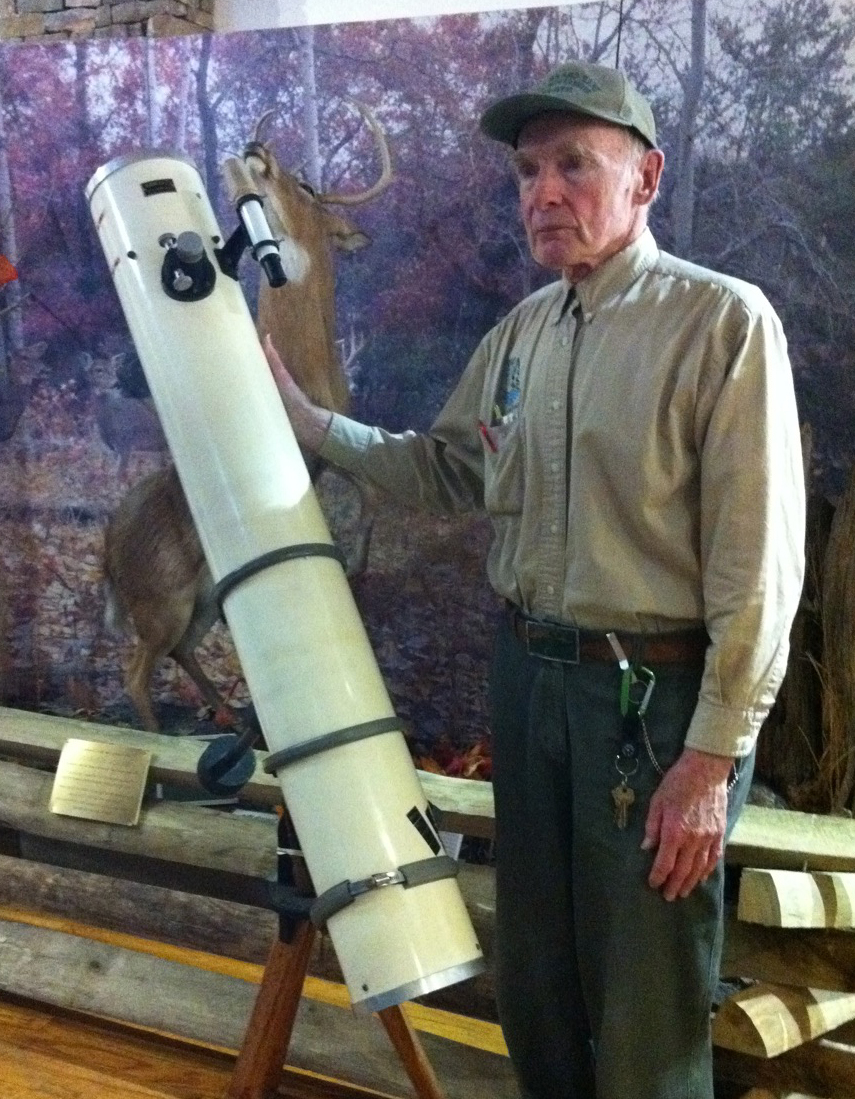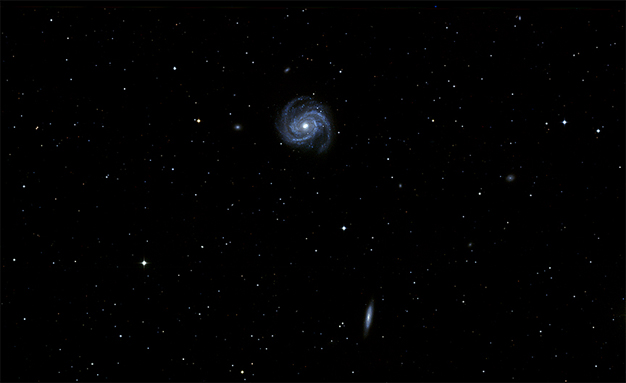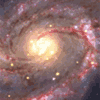Disclaimer: This material is being kept online for historical purposes. Though accurate at the time of publication, it is no longer being updated. The page may contain broken links or outdated information, and parts may not function in current web browsers. Visit chandra.si.edu for current information.
The Man Who Discovered SN 1979C and Beat the Machines
by Peter EdmondsNovember 16, 2010 ::
Discoveries in astronomy can involve some of the most sophisticated
instruments ever built, operated by scientists with years of academic study
behind them. Or, they can be made by amateurs using relatively simple
instruments, backed up by experience, keen eyes, and a dark sky. The new
result on SN 1979C involves both: beginning with the discovery
of the supernova by Gus Johnson, an amateur from Swanton in western
Maryland, followed by observations with a suite of major modern
observatories, including Chandra. Because of its proximity and interesting
properties, SN 1979C is now considered to be one of the most famous of all
supernovas.
With his discovery, Gus Johnson became only the third person to find a supernova in another galaxy by direct observation. His discovery of SN 1979C was a source of inspiration for Reverend Robert Evans, the famous amateur from Australia, who discovered his first supernova in 1981 and found dozens more.
We interviewed Gus to hear some of the story behind his discovery and to learn about his other scientific interests.
CXC: How did you develop an interest in astronomy, and particularly the
Virgo Cluster?
GJ: Astronomy captured my interest around 1952 after browsing through an
encyclopedia in my 8th grade classroom. A year later, I started getting
"Sky and Telescope" magazines, and now have about 55-years worth. The
February 1954 issue had a chart for finding galaxies in the Coma-Virgo
Cluster, a chart made by Leland Copeland. I had neither dark skies nor a
reasonably-sized telescope for actually seeing the fascinating objects
described, as I lived in a town, Vandergrift, PA, and later
Pittsburgh. Around 1967, I had a fine Cave 6-inch reflector and relatives
with a farm in central PA, and it was there that I took my first tour of
those galaxies. I was living at Deep Creek Lake in western Maryland with
fairly dark skies, though many trees limited my sky. By the mid-1970s, I
had moved to a small place with a less obscured sky. I liked to make at
least one annual tour through those galaxies, with no scientific purpose,
just enjoyment, though I belonged to the (Amateur Association of Variable
Star Observers) AAVSO and did do that form of research.
CXC: What are some of the details behind your discovery of SN 1979C?
GJ: In 1979, the minister of my church was a young man interested in
astronomy, so I took him on a tour of the Coma-Virgo Cluster. And it was on
that night that when we viewed M100 that for some reason I felt I should
check on a little star near the galaxy's edge. I think I put off checking
until the next day, April 19th, when I did not find that star on a Palomar
photo, after which I phoned the AAVSO of a possible supernova. They sent
out the alert, and soon it was confirmed by Asiago and McGraw-Hill
Observatories. I followed its progress until it slipped into the trees west
of my home. I have strange quirks of memory and don't know why that little
star caught my attention; maybe I had a subconscious memory of a photo of
it. I still use Leland Copeland's chart, and recently made a larger one
strongly based upon Copeland's. This is a cloudy area, so I am limited in
how many tours of the region I can make, and numerous other galaxies around
the sky I like to check for supernovae, having some supernova (SN) search
charts, photos and my own sketches. It was an exciting discovery for me.
CXC: What do you think your chances would be of repeating this discovery
today?
GJ: With all the competition of large amateur telescopes and
computer-animated systems, I have little hope of finding another supernova,
yet it is fun to try. Back in 1979 there were some automated systems, but
they missed the M100 supernova. Maybe they had cloudy skies, or the
computer was "down." I felt rather like the mythological John Henry, who
beat the machine.
CXC: Did you have competition for this discovery?
GJ: "Sky and Telescope" reported the SN in their June and July 1979
issues. The July issue, page 90, reports that on April 18-19, 1979,
G. Kuipers, of Zuidhorn, the Netherlands noted a star in M100 that caught
his attention, but then he found it on a photo, "but had doubts when he
could not recall another star which appeared of equal brightness in the
photograph. Cloudy weather prevented further observation until Mr. Kuipers
learned of the supernova's discovery." How well I know that cloudy weather
problem!
CXC: Did you make any other discoveries in astronomy?
GJ: SN 1979C is the only notable discovery I ever made. Using AAVSO
variable star charts I occasionally note a star not at the listed
magnitude. It was so with two 14th magnitude stars close to M100, hardly a
"discovery" but more of some interest. I also made a possible discovery of
a variable star near galaxy NGC 7606 in Aquarius, but this, though
reported, has not apparently stirred interest.
CXC: How do you like to make observations?
GJ: I have about a dozen telescopes, from 1.6-inch to 8-inch diameters. All
are portable, since a fixed observatory here would have too restricted
skies. I like observing in a low-tech manner using star trails to my
target objects and not using go-to computerized telescopes. I feel a bit
like the British astronomy popularizer, Patrick Moore, who prefers to not
use computers and uses an antique typewriter. I've memorized the positions
of about 250 objects, and have made many charts for at-the-telescope use.
CXC: After retiring as a middle school teacher, what other work have you
been involved in?
GJ: For decades I did volunteer work at several local state parks: Swallow
Falls State Park, Herrington Manor State Park, New Germany State Park and
Deep Creek Late State Park, as well as at two in West Virginia, mostly
helping with astronomy programs. For about a decade now I have been a paid
employee (and volunteer) at the Deep Creek Park. I am paid for general
maintenance work, but lead astronomy programs and an occasional nature
walk. At the Deep Creek park, I work at their Discovery Center; my boss,
Caroline Blizzard also enjoys astronomy, and is a big help. One of our
programs is the raising of monarch butterflies, and in this I may have made
a minor discovery, that their chrysalises, of somewhat irregular shape,
align in a certain direction, suggesting to me that they may use the
Earth's magnetic field, in part, for their amazing migrations.
Disclaimer: This material is being kept online for historical purposes. Though accurate at the time of publication, it is no longer being updated. The page may contain broken links or outdated information, and parts may not function in current web browsers. Visit chandra.si.edu for current information.







